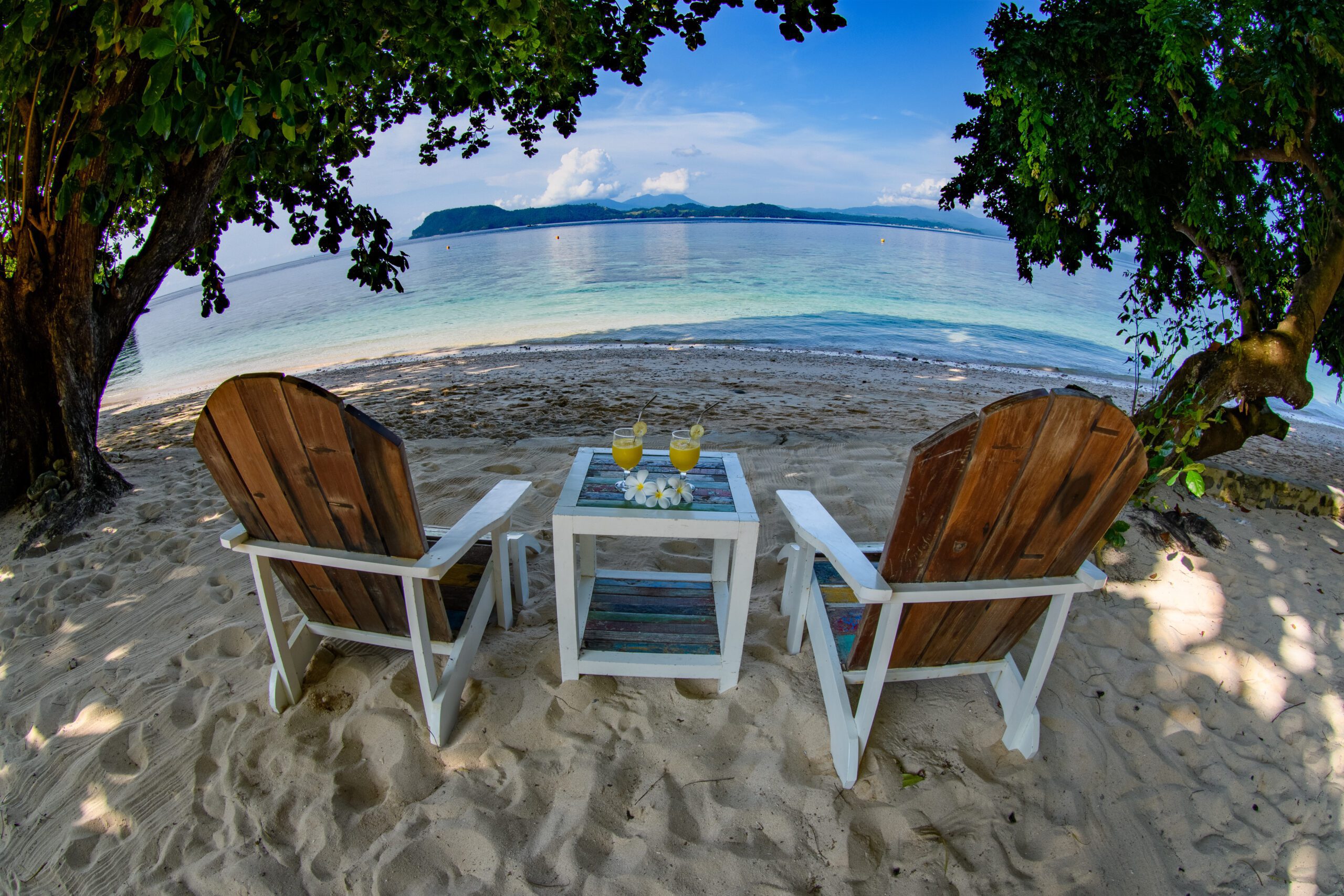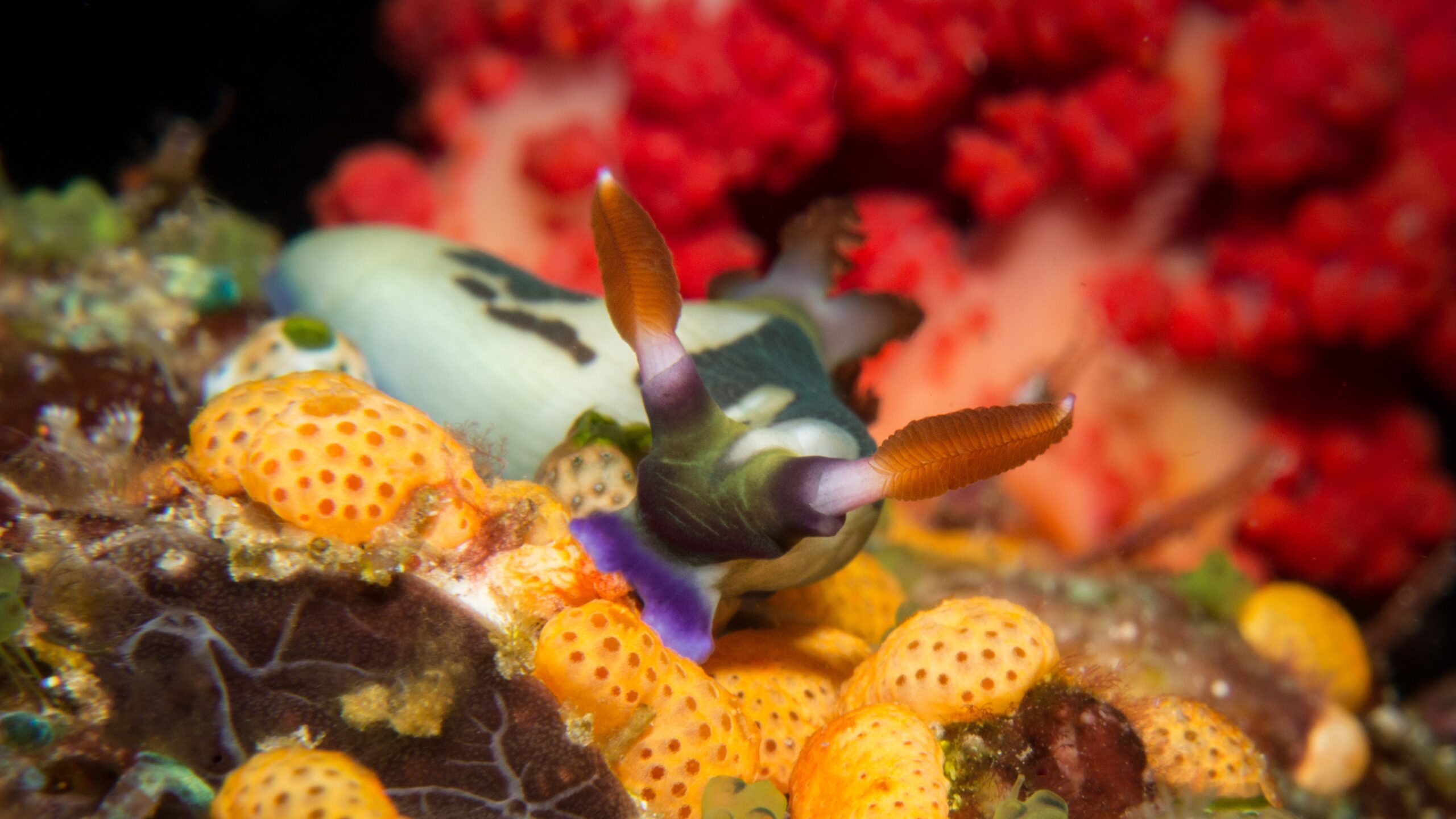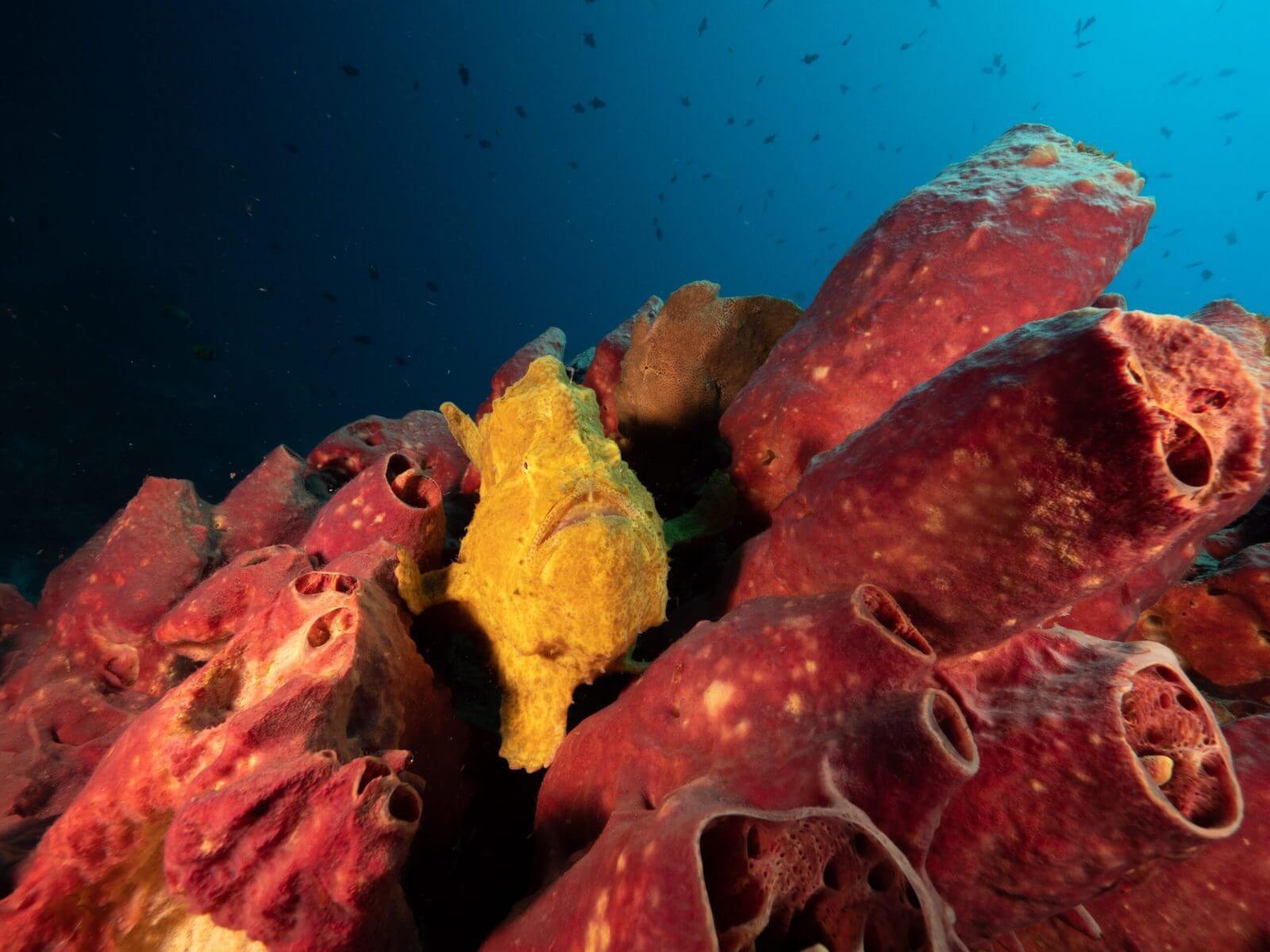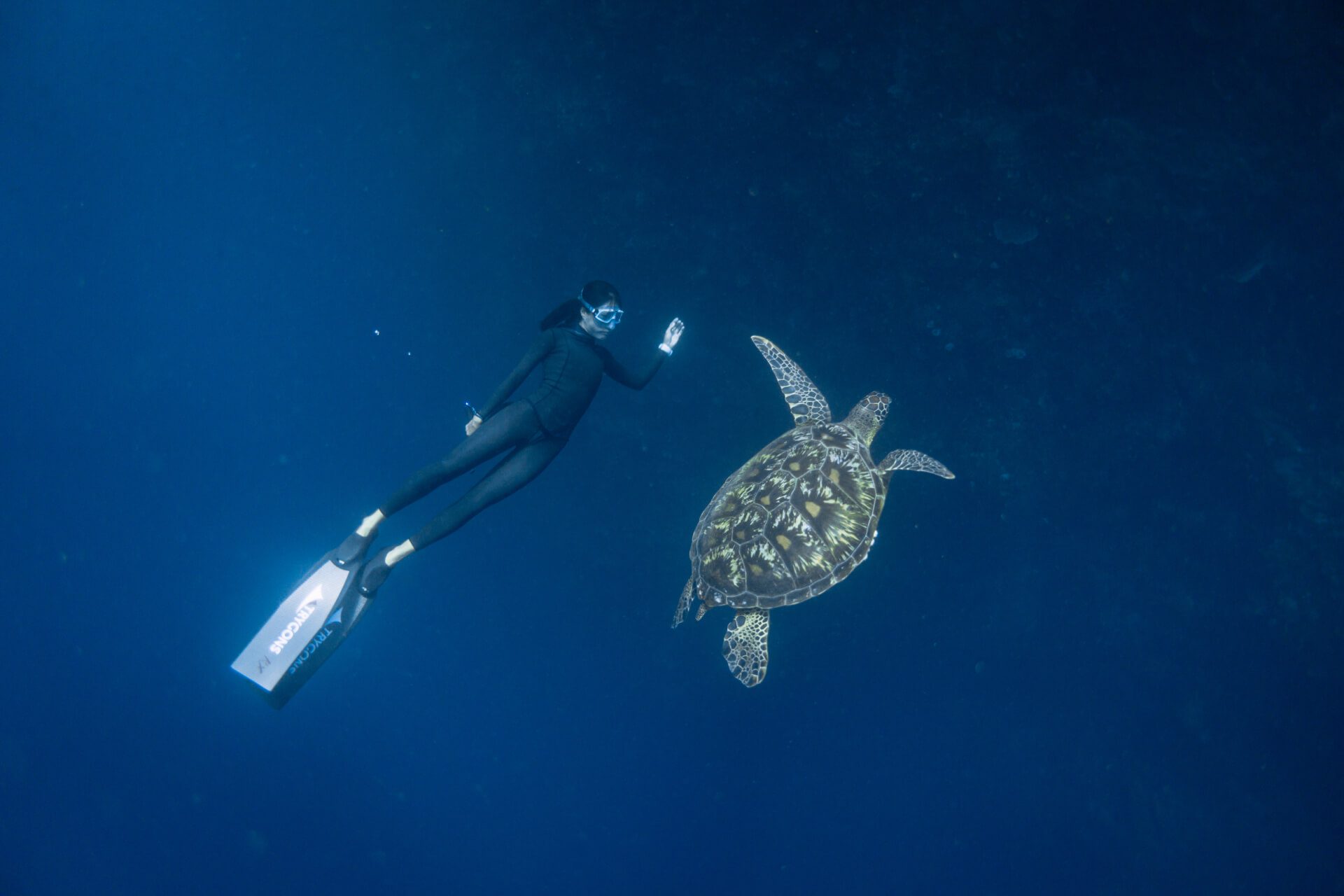Murex Bangka Resort House Reef Diving 101
|June 26, 2024
For many divers, snorkelers and freedivers, staying at a resort that has a good house reef is a major bonus. What could be better than taking your diving at a pace that suits you and by simply stepping out into calm, clear, and warm tropical water? At Murex Bangka in North Sulawesi, we not only have a house reef that is just a step off the beach, but we have an exceptional house reef that is packed with vibrant corals, teeming with fish, and bursting with color.
In this Blog, we dive deeper into Murex Bangka’s house reef and explore some of the marine life highlights of this superfluous dive site….
Location, Location, Location
When we say that our House Reef is just a step off the beach, it really is just a step off the beach!
Entry to the Bangka House Reef is by making a shore entry near where the boats are moored. The boat mooring area covers a sandy channel which allows for walking out to water deep enough in which to don fins without damaging any corals. Once you are ready, swim out, following the sandy channel, until you are deep enough to make a descent with your buddy or submerge as you swim.
Once you reach between 4-5 meters deep, the reef crest is in view and the sloping reef drops off before you – it really couldn’t be easier!;
Note on Exits: To avoid damaging coral life when exiting the House Reef you should aim to return to this entry point. Make a shore diving exit by removing your fins and walking back to the beach via the sandy boat mooring channel.
Bangka House Reef Dive Site Overview
The slope of the Murex Bangka Resort house reef begins at around 5meters/16 feet. The slope angles downward at around 45° to a maximum depth of approx. 25-27meters/82-89 feet, where it peters out into a flat, bright white, sand bottom.
Topographically, the Murex Bangka House Reef can be broken down into 3 main sections, which are determined by depth:
-
Shallow Branching Coral Reef Top: 0-5 meters/0-16 feet
Upwards of around 5 meters (16 feet), and closest to the shore, there is a predominantly branching coral reef top. These shallow corals occupy the majority of the bay in front of the resort. The branching corals are punctuated by sandy patches and sporadic rock and hard coral bommies. Corals here are primarily hard corals but in some of the deeper sections, it’s possible to find soft corals that have attached themselves to available surfaces.
Among the branching corals there are schools of damselfish and other typical Indo-Pacific reef fish. Common species include angelfish, butterflyfish, parrotfish, and cardinalfish. The sandy patches are also home several species of blind shrimps and gobies living and working together in symbiosis.
Look out for blue spotted stingrays on the sandy patches, occasional passing sea snakes, and take time to inspect the bommies for camouflaged scorpionfish, frogfish, ghost pipefish and nudibranch.
-
Sloping coral reef: 5–25 meters/16-82 feet
The sloping reef is where divers spend the majority of the dive. Diving the Bangka Resort house reef is an ‘out-and-back’ dive, meaning that divers swim out along the reef with the slope to their left shoulder. Upon reaching the pre-planned turning point (determined by either dive time or remaining air) the dive is turned for the return swim to the exit point. The return swim is with the right shoulder to the reef and gradually shallowing up along the way.
The slope offers a diverse mix of hard and soft corals in all shapes, sizes, and colors. Look out for blue tipped table corals, leather corals, black corals, brain corals and sponges. The vibrant pink, red and orange soft corals are especially impressive when there is some current. The current is usually the result of tidal movements (the tide coming in or going out) and this brings with it a consistent flow of nutrient-rich water. Soft corals feed by opening up in a flower-like way so they are able to catch plankton particles as they drifts past.
There is no shortage of things to see on this packed sandy slope and because the return swim is shallower, you’ll be constantly discovering new areas of the reef, different corals and even more diverse marine life.
-
White sand bottom: approx. 25-27 meters/82-89 feet
Whether you choose to explore the white sand bottom before heading back along the slope depends on your air consumption, remaining dive time, and the dive conditions. The most interesting part of the white sand is where it joins the base of the slope. Where these two sections meet there is a mix of sand, stones, and small corals which seem to make an attractive combination for a number of critters. Taking some time to look out over the white sand flat can be rewarding with sightings of schooling fish, predatory pelagics passing through (see marine life highlights), and other interesting bottom dwellers hiding in plain sight on the sand.
Marine Life Highlights on Murex Bangka Resort House Reef
This is house reef diving that just keeps on giving – the more you dive here, the more will be revealed!
Of course, like any dive site, there are fish and critters that reside here and can be seen on almost every dive. However, the house reef is also known for ‘surprise’ sightings of larger, and often predatory, species passing through. When diving the house reef, it’s easy to get lost in the sloping reef and all that resides there, however, keep an eye out to the blue. Swooping eagle rays, patrolling reef sharks and schools of snappers, fusiliers and mackerel are all known to pass through.
Below is an introduction to some of the most common species that we see on the Murex Bangka Resort House Reef:
Cephalopods:
A variety of cephalopods visit or reside on the Murex Bangka resort house reef. One of our most common sightings is of common reef octopus that reside on the sloping reef, the reef crest, and among the branching corals on the reef top. Reef octopus have no shortage of food here as the site is packed with small fish and crustaceans that the octopus can feed on.
From time to time, broadclub cuttlefish are also spotted around the reef crest – this species is known for laying its eggs inside branching corals – of which there are plenty on the reef top.
Finally, look up to the surface from the reef crest and there are often reef squid hanging in the blue close to the boat mooring lines. On bright sunny days, these beautiful creatures make stunning underwater photography subjects.
Crustaceans:
There is no shortage of shell-clad critters on the Murex Bangka Resort House Reef. Choose from tiny commensal shrimp that live among the anemones and corals, through to larger nocturnal sponge crabs that can be spotted during night dives.
Peacock and pink-eared mantis shrimps are regulars here and these shy critters can be seen hiding underneath corals and ledges.
Where the white sand bottom meets the base of the sloping reef, look for gobies with their blind shrimp partners, working together in symbiosis to build their burrow.
Some marine species including moray eels, batfish, angelfish and other medium to large sized reef fish visit the house reef for cleaning and as such, there are a number of ‘cleaning stations’ on the reef where such fish will go for cleaner shrimp to get to work on them – cleaning around the teeth, eyes, and gills, and removing parasites, dead skin and any areas of infection.
Other common crustaceans found here include sexy shrimp, emperor shrimps, orangutan crabs, porcelain crabs, hairy squat lobsters and candy (soft coral) crabs.
Night diving: For those who want to see the true spectrum of crustaceans that reside here, we recommend taking a night dive. Night dives on the Murex Bangka house reef reveal a whole new host of nocturnal critters.
Nudibranch:
Nudibranch are spotted on the Murex Bangka Resort House Reef all year round. The specific species that we see changes with the seasons and even as frequently as the months of the year. It’s not unusual to see nudibranch mating here or ribbons of nudibranch eggs.
Schooling Fish:
Looking out to the blue, schools of fusiliers, rainbow runners, snappers, mackerel and jacks are seen streaming through.
Reef Fish:
The House reef is alive with reef fish and you can expect to see a broad spectrum of Indo-Pacific reef fish including angelfish, butterflyfish, parrotfish, triggerfish, Moorish idols, anemonefish, puffers and boxfish, batfish, sweetlips – and the list goes on….
Among the more unusual reef species seen here are pygmy seahorses (Pontohi and Bargibanti), frogfish and crocodile flathead.
Pelagics/Predators:
Predatory species are also often spotted in the blue, look out for possible barracuda, tuna, reef sharks and Spanish mackerel.
Rays:
Blue spotted ribbon tail rays and Khul’s sting rays are often seen on sandy patches on the reef top and on the white sand bottom. Spotted eagle rays are seen with frequency in the open water – or swooping down to the white sand bottom.

Murex Bangka House Reef Diving Tips
If you are planning to stay at Murex Bangka Resort and take advantage of the unlimited House Reef diving, here are a few tips that will help to enhance your experience.
Note: Many of these tips also apply to those who are planning to swim, snorkel, or freedive on the house reef.
-
Take a Dive Guide with you on your first dive:
Although some of our dive packages include unlimited self-guided house reef diving, we recommend taking a Murex Resorts Dive Guide with you on your first dive. Your guide will assist with initial orientation, advise you regarding entries and exits, and point out some of the more unusual and interesting marine species.
-
Tell Murex Resorts staff you are diving and what time:
If you are diving the house reef with a buddy, let Murex staff know what time you are diving and for how long. This not only increases safety but our dive center team will also prepare your gear and tanks in advance.
-
Time your dives:
When diving the house reef, it is best to time your dives with the tides and currents. Check with the dive center team the best time to dive on each day.
-
Good diving practices:
Observe general good diving practices during your dives. Good diving practices include:
- Maintain neutral buoyancy and minimize contact with the reef
- Look but don’t touch
- Do not harass, chase, or stress marine life
- Maintain constant buddy contact
- Check your tank pressure frequently
- Dive within your limits (and any limits of your diving certification)
- Plan your dive and dive your plan
- Practice a 3minute safety stop at 5meters at the end of every dive.
Freediving in Bangka and North Sulawesi
Did you know that the Murex Bangka Resort House Reef also offers excellent opportunities for freedivers? If scuba diving is not for you – or if you are a diver and want to try something new, we offer the full range of AIDA free diving courses! For certified freedivers, the house reef is a beautiful site for all levels.
Join Us For A Passport To Paradise
If you are trying to decide where to stay in North Sulawesi then why not join us for a Passport to Paradise? Instead of limiting yourself to one destination, explore all three of our distinct diving destinations in one easy trip: Bunaken, Bangka , and Lembeh.
Our resorts are connected by boat diving transfers. There is no wasted travel time and even more time underwater as you simply dive your way from resort to resort!
Not only does Murex Bangka offer a stunning Resort House Reef, Murex Manado and Lembeh Resort have incredible house reefs too!
Get In Touch!
Contact us at reservations@murexresorts.com. You may also want to check out Murex Resorts’ rates and reserve your spot now.
We look forward to welcoming you to North Sulawesi!
FURTHER READING:
If you enjoyed reading this, you may also be interested in some of our other recent articles:
- Useful Indonesian Phrases for Travelers
- How to Arrange a Sustainable Trip in Indonesia
- Enhance Your Dive: Must-Have Scuba Skills for North Sulawesi
The post Murex Bangka Resort House Reef Diving 101 appeared first on Murex Resorts.





